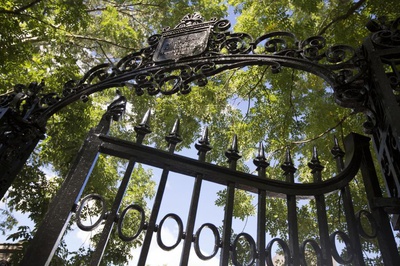
News
Nearly 200 Harvard Affiliates Rally on Widener Steps To Protest Arrest of Columbia Student

News
CPS Will Increase Staffing At Schools Receiving Kennedy-Longfellow Students

News
‘Feels Like Christmas’: Freshmen Revel in Annual Housing Day Festivities

News
Susan Wolf Delivers 2025 Mala Soloman Kamm Lecture in Ethics

News
Harvard Law School Students Pass Referendum Urging University To Divest From Israel
Harvard Ballet Company Presents a Jubilant 'Oz'
The gentle strums of a ukulele opened “Oz,” Harvard Ballet Company’s fall offering. Israel Kamakawiwo’ole’s dreamy rendition of “Somewhere Over the Rainbow” floated through the theater as the dancers began. Their gestures were yearning and explorational. They began and ended the first dance on the ground, with their hands folded mute and uniform. But in the space between, they reached their hands up towards the sky and stretched their arms and necks to make birdlike shapes.
“Oz” is ostensibly a retelling of the “Wizard of Oz.” There was a delightful Dorothy with her pigtails and blue skirt and red ruby slippers (in this case, socks), and her three fabled compatriots: the Scarecrow, the Tin Man, and the Cowardly Lion. There were the whimsical Emerald City citizens decked out in mint green and chocolate, bouncing about to the percussive sounds of tap dance. There was the pristine Good Witch of the North, who smiled a large cheesy smile at the end of a conventional prima ballerina solo, and there was the angular, languidly powerful bravura of the Wicked Witch of the West. And of course there was the grand Wizard himself. But the ballet went beyond this rehashing of familiar figures. It took advantage of the story’s remarkably flexible iconography to turn “Oz” into a fresh meditation on personal journey and authenticity.
The centerpiece of “Oz” was its elegant reimagining of the Yellow Brick Road in the transitions between dances. In these recurring interludes, single soloists dressed in black danced to the sound of “Mishima/Closing,” an excerpt from Philip Glass’s String Quartet No. 3, under a spotlight filtered through an abstract brick road pattern. With each new soloist’s interpretation the repeating music seemed to deepen in both familiarity and mystery.
The ballet concluded with two scenes that diverged significantly from the original story, called “To Dwell: There’s No Place Like Home,” and “Paper Trails: Self-Discovery.” In these last two scenes the dancers shed any vestige of the magic and colors of the Oz dreamland. This stylistic transition was made less jarring by its foreshadowing in the tornado scene, in which dancers dressed in gray moved angularly and chaotically to Alfred Schnittke’s metallic, off-kilter Gogol Suite. And the interludes, with music that so well evoked a yearning, searching mood, made a finale titled “Paper Trails: Self-Discovery” thematically fitting, although some of the symbolism grew more abstruse towards the end.
The ballet took its most poignant and unexpected turn with the unmasking of the Wizard. The scene opened with the dancers wearing black, stony-faced masks and the leader directing them to move in a uniform, march-like fashion. All the masked dancers bent at the waist with their hands clasped demurely behind their backs. The Wizard seemed to hide behind his position as leader of these masked, de-individualized marchers. The ballet took liberties with the original story to great effect, imagining that a beautiful relationship between Dorothy and the Wizard blossomed as Dorothy encouraged the Wizard to remove the mask, to be real and vulnerable.
The ballet turned this unmasking gesture into something that might resonate with an audience full of Harvard students. In the penultimate scene the dancers said aloud together the popular self-empowering slogan, “You are enough.” It was surprising to hear a human voice in the theater, and the audience had a clear view of the directors’ vision for this retelling of “Oz.”
The slogan “you are enough” seemed to manifest itself in Dorothy, who in the “Friendship Quartet” scene danced to the sounds of Simon & Garfunkel singing, “Got no deeds to do, / No promises to keep. / I’m dappled and drowsy and ready to sleep. / Let the morning time drop all its petals on me. / Life, I love you, / All is groovy.” The choreography for Dorothy, the Scarecrow, the Tin Man, and the Cowardly Lion was full of skipping, tripping, exploring, and simply taking in the wonders of the colorful landscape. The dancers created a dream world somewhere over the rainbow on the stage and encouraged the audience to take some of this wide-eyed spirit with them even after the show had ended.
Want to keep up with breaking news? Subscribe to our email newsletter.
From Our Advertisers

Over 300+ courses at prestigious colleges and universities in the US and UK are at your disposal.

With innovative financial tools combined with financial education, Collegiate empowers students to take control of their finances and build confidence in their money management skills.

Serve as a proctor for Harvard Summer School (HSS) students, either in the Secondary School Program (SSP), General Program (GP), or Pre-College Program.

With an increasingly competitive Law School admissions process, it's important to understand what makes an applicant stand out.

Welcome to your one-stop gifting destination for men and women—it's like your neighborhood holiday shop, but way cooler.

Admit Expert is a premium MBA admissions consulting company, helping candidates secure admission to top B-schools across the globe with significant scholarships.
